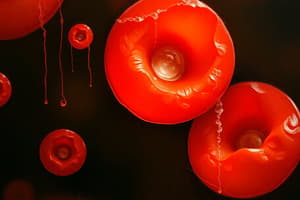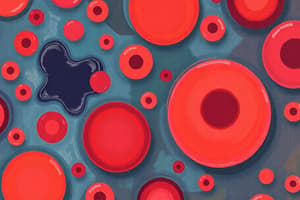Podcast
Questions and Answers
What is the average diameter of erythrocytes?
What is the average diameter of erythrocytes?
- 9 μm
- 7.5 μm (correct)
- 6 μm
- 12 μm
Which type of leukocyte comprises 60-70% of circulating leukocytes?
Which type of leukocyte comprises 60-70% of circulating leukocytes?
- Neutrophils (correct)
- Lymphocytes
- Eosinophils
- Basophils
What is the life span of erythrocytes?
What is the life span of erythrocytes?
- 10-15 days
- 1-4 days
- 20 days (correct)
- 8-12 days
Which type of leucocyte is characterized by a bilobed nucleus?
Which type of leucocyte is characterized by a bilobed nucleus?
What characteristic granule type is found in basophils?
What characteristic granule type is found in basophils?
Which types of cells are derived from myeloid stem cells?
Which types of cells are derived from myeloid stem cells?
What is the typical diameter range for microcytic erythrocytes?
What is the typical diameter range for microcytic erythrocytes?
Which leukocyte type has a life span of 10-15 days?
Which leukocyte type has a life span of 10-15 days?
Which of the following is NOT a characteristic of erythrocytes?
Which of the following is NOT a characteristic of erythrocytes?
What is the role of lymphocytes in the immune system?
What is the role of lymphocytes in the immune system?
Flashcards
Erythrocytes (Red Blood Cells)
Erythrocytes (Red Blood Cells)
The most numerous cells in the blood, responsible for oxygen transport. They are flexible, biconcave discs with a diameter of 6-9 μm and a thickness of 2.5 μm at the rim, but only 0.75 μm in the center.
Preparing a Blood Smear
Preparing a Blood Smear
The process of creating a thin layer of blood on a slide for microscopic examination. This allows for the visualization and analysis of blood cells.
Hematopoiesis (Blood Cell Formation)
Hematopoiesis (Blood Cell Formation)
The process of developing blood cells from their parent cell.
Erythropoiesis (Red Blood Cell Production)
Erythropoiesis (Red Blood Cell Production)
Signup and view all the flashcards
Mature Red Blood Cells
Mature Red Blood Cells
Signup and view all the flashcards
Leucocytes (White Blood Cells)
Leucocytes (White Blood Cells)
Signup and view all the flashcards
Neutrophils
Neutrophils
Signup and view all the flashcards
Eosinophils
Eosinophils
Signup and view all the flashcards
Basophils
Basophils
Signup and view all the flashcards
Monocytes
Monocytes
Signup and view all the flashcards
Study Notes
Stages of Blood Cell Development
- Blood is composed of water, plasma proteins (albumins, globulins, fibrinogen, regulatory proteins), electrolytes, nutrients, respiratory gases, waste products, erythrocytes, leukocytes, and platelets.
- Erythrocytes (RBCs) are the most abundant blood cells.
- Shape: Flexible, biconcave discs
- Size: Diameter 6-9 µm (average 7.5 µm), Thickness: about 2.5 µm at the rim and 0.75 µm in the center.
- Non-nucleated
- Appear ac-dophilic with a pale center
- Life span: 120 days, then they're engulfed by macrophages.
- Abnormal shapes include sickle-shape and spherocytosis (biconvex).
- Abnormal sizes include microcytic (diameter < 6 µm) and macrocytic (diameter > 9 µm).
- Leukocytes (WBCs) are a crucial part of the immune system.
- Types: Neutrophils (60-70% of circulating leukocytes, 12-15 µm in diameter, segmented nucleus, cytoplasmic granules), Basophils (less than 1% of circulating leukocytes, 12-15 µm in diameter, bilobed nucleus, characteristic cytoplasmic granules, life span of 10-15 days), Eosinophils (2-4% of circulating leukocytes, 12-15 µm in diameter, bilobed nucleus, characteristic cytoplasmic granules, life span of 8-12 days), Monocytes (3-8% of circulating leukocytes, largest in blood smear, 15-20 µm in diameter, large indented or kidney-shaped nucleus, basophilic cytoplasm with azurophilic granules, life span of 3 days), Lymphocytes (20-25% of circulating leukocytes, 10-12 µm in diameter, small, spherical, highly condensed nucleus with rim of cytoplasm).
- Platelets (thrombocytes) are cell fragments crucial for blood clotting.
- Diameter: 2-4 µm
- Normal count: 150,000 to 400,000/µL of blood
- Life span: about 10 days
- Appear in clumps in stained blood smears.
Blood Smear Preparation
- Collect a small blood sample.
- Place a drop of blood on a slide.
- Using a second slide, spread the blood into a thin film.
- Allow to dry and stain.
- View under a microscope to see the different blood components
Hemopoiesis
- Hemopoiesis in the bone marrow results in the formation of blood cells.
- Hematopoietic stem cells are the precursors of all blood cells.
- Myeloid stem cells differentiate into erythrocyte, platelets, and granulocytes (neutrophils, eosinophils, basophils) and monocytes.
- Lymphoid stem cells differentiate into lymphocytes (B cells, T cells, NK cells).
Studying That Suits You
Use AI to generate personalized quizzes and flashcards to suit your learning preferences.
Related Documents
Description
Explore the fascinating stages of blood cell development, focusing on erythrocytes and leukocytes. This quiz covers their structure, types, functions, and abnormalities. Test your knowledge on the cellular components of blood and their roles in the immune system.




